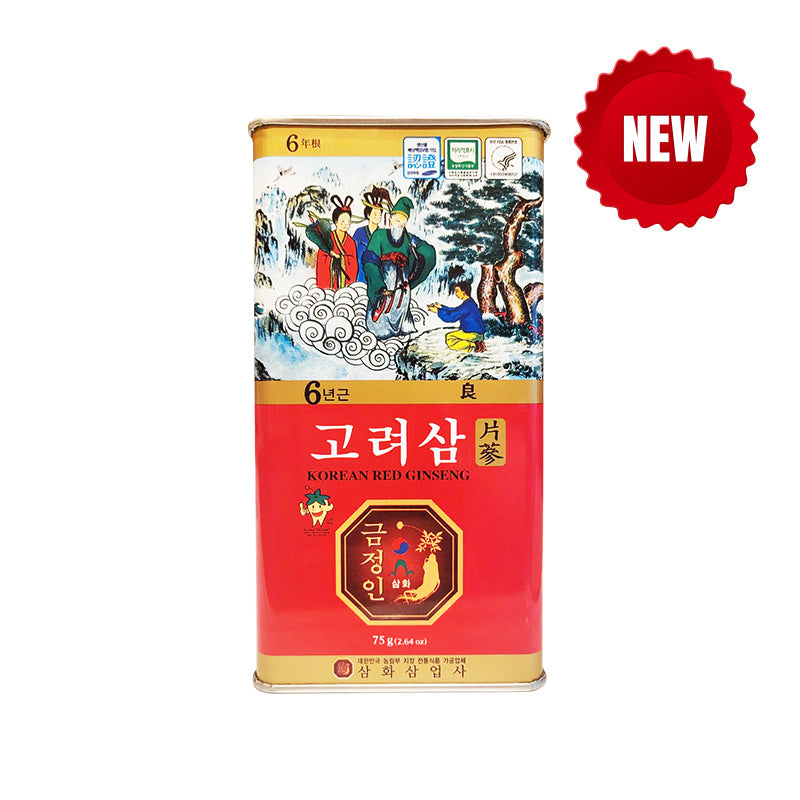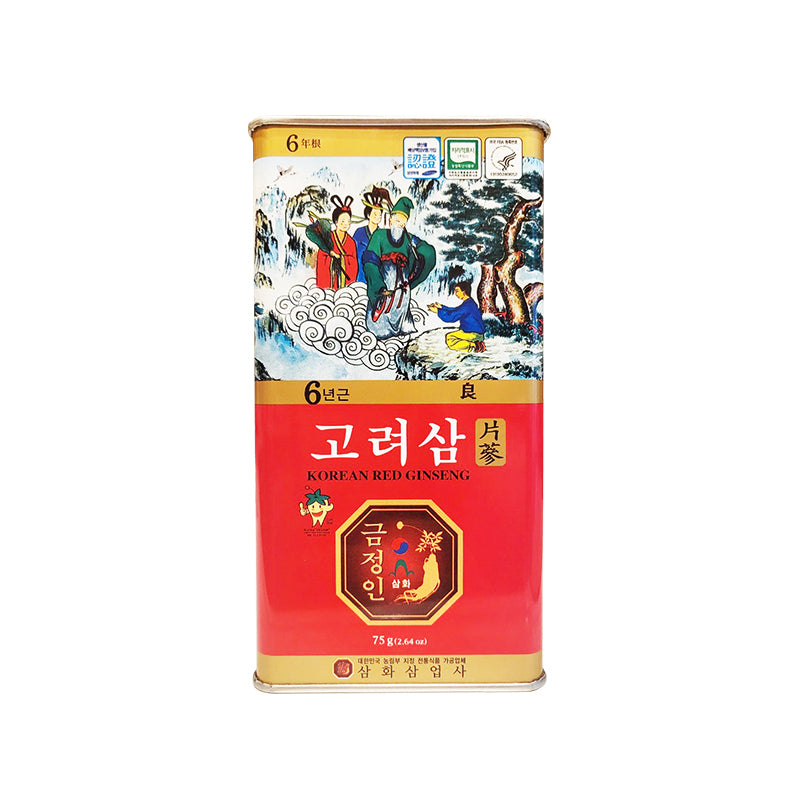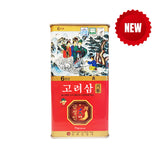Korean Red Ginseng Sliced Roots (75g/can)
Free Shipping
Free Shipping on orders over $100+
• Product Name : Korean Red Ginseng Sliced Roots (75g/can)
• Year of raw material ginseng production: 2020-2021
• Net. WT.: 75g
• Year : 6 Years
• Grade : Passed Grade
• Size : Sliced Roots for 75g
• Food paper + wooden box + metal can
• Quality Assurance Period : 10 years from date of manufacture
• Country of Origin : Republic of Korea
• Storage: Avoid direct sunlight and store in a cool place.
1) Hongsam sliced ginseng is a product made with 100% red ginseng root material. It is cut diagonally to fit into the mouth and chewing it or suitable to brew it for tea. It is a simple and practical product that is packed in a wooden box of 75g each so that there is no problem for a long time storage.
2) Information on Red Ginseng
[Differences between fresh ginseng, red ginseng, and black ginseng]
Ginseng can be categorized into ① fresh ginseng, ② red ginseng, and ③ black ginseng, depending on how it is processed.
① Fresh Ginseng
A term referring to ginseng which has not yet been processed after harvesting. It is also called raw ginseng. As the name suggests, 75% of fresh ginseng is moisture. Not only is it difficult to store them fresh for more than one week, but there is also a risk that they may rot or spoil during circulation. Thus, red ginseng or black ginseng, which are processed outcome of fresh ginseng, are more frequently used.
② Red Ginseng
As a health supplementary food loved by the majority of the Korean population, red ginseng makes up about 36% of total sales of health supplements. Red ginseng is made by steaming fresh ginseng in at approximately 98 degrees and then drying them (which is then repeated 2-4 times). Korean Red Ginseng gets its name from the reddish color of its exterior.
Because red ginseng is a food made by processing fresh ginseng, it can be stored for a long period of time without any change in its ingredients, thus making it easy to store. In the process of steaming and drying the fresh ginseng, toxins from fresh ginseng are eliminated. At the same time, saponin, which does not exist in fresh ginseng, is created. Therefore, red ginseng components have many helpful effects, such as improving immunity, relieving fatigue, antioxidation, physical improvement, and so on.
③ Black Ginseng
Recently, black ginseng has been gaining more attention than red ginseng. Black ginseng may sound very unfamiliar compared to red ginseng, but the biggest difference between red and black ginseng is in the number of times they are processed through steaming and drying. Whereas red ginseng is processed by steaming and drying fresh ginseng 2-4 times, black ginseng goes through the same process 9 times. This process is also called 9-joong-9-po (九蒸九曝) in Korean.
3) The reason for making red ginseng through the process of steaming and drying several times
Usually, only the highest quality fresh ginsengs out of the 6-year-old ginsengs are chosen for the process of repeated steaming and drying until their moisture content becomes less than 14%.
In the process of manufacturing red ginseng, the nonenzymatic bronzing response is accelerated and bronzing reaction products are formed. Among those products, antioxidation components such as Maltol are produced in abundance. It was also found that new active ingredients such as ginsenoside Rh2, which suppresses propagation of cancer cells, and panaxytriol are created in the process.
4) Differences in the Components of Red Ginseng and Black Ginseng
As mentioned above, a huge difference between red ginseng and black ginseng is found in their components formed through the creation process.
The repeated process of steaming and drying the fresh ginseng will reduce the net weight of the ginseng to 1/5 of its original weight, but the amount of saponin in ginsenoside found only in ginseng increases 20-fold.
This is not the only difference between red ginseng and black ginseng. As for saponin, a component beneficial to the human body, to be absorbed, it must be absorbed inside the body. Whereas macromolecule saponin Rb1, Rb2, Rc, and Rd generally contained in red ginseng are not well absorbed inside the body, small molecule saponin such as Rg3, Rg5, Rk1, and Rh1 found in black ginseng, which went through more processing cycles compared to red ginseng, are more easily absorbed inside the body. More simply, the components of ginseng tissue in firm sol condition change into soft gel condition as the steaming and drying process is repeated more than 3 times. As a result, red and black ginseng are more easily absorbed by the body compared to fresh ginseng.
5) Do not take the following foods with red ginseng:
It is recommended to avoid caffeine, high blood pressure medication, estrogen (female hormone medications), and medications for mental illnesses when consuming red ginseng. Since red ginseng has an effect of accelerating high blood pressure and nerves, consuming it with corresponding medications may intensify the medicinal effect and possibly cause side effects.
6) It may cause trouble when mixed with red ginseng: “Well-matching Food with Red Ginseng that becomes Medicine”
There are foods that are a good or bad match with red ginseng. However, you must always be cautious since even the foods known to match red ginseng may not be suitable for you.
① Red ginseng + honey: Taking red ginseng, which is low in calories, with honey will supplement for lacking calories. Honey helps digestive absorption.
② Red ginseng + jujube: Jujube warms your body and relaxes your nerves. It goes well with ginseng as well.
③ Red ginseng + milk vetch root: Iimproves lung function and controls sweating.
④ Red ginseng + Chinese yam: Increases energy and strengthens bronchial tubes.
⑤ Red ginseng + Rehmannia glutinosa: Controls high blood pressure and supplements the essence of your body.
⑥ Red ginseng + Big blue lilyturf + fruit of schisandra chinensis: A nice drink for summer. It helps with lung function and compensates for nutrients lost from sweating.
⑦ Red ginseng + chicken: Neutralizes the unique odor of chicken and supplements energy.
7) Effects of Red Ginseng
① Helps improve immunity.
② Suppresses the propagation of cancer cells.
③ Helps to improve memory (improves brain health). It is effective against forgetfulness and in preventing dementia.
④ Since the drink helps recover from fatigue, it is good for those who often feel tired.
⑤ Helps in recovering from hangovers.
⑤ Highly effective in improving potency.
⑦ Prevents osteoporosis and anemia.
⑧ Effective at overcoming menopause disorders.
⑨ Effective at treating insomnia.
⑩ Effective at preventing aging.
⑪ Helps with improving dermatological health.
GEUMSAM
A term referring to red ginseng from Geumsan. Geumsan, Korea, is the primate land of Korean ginseng with history of 1500 years with 3,000 mountains, clear water from the upstream of Geumgang River, fertile land containing germanium component, and land form of mountain basins which provide the optimal environment for ginseng growth. Top-notch ginsengs grow in Geumsan, which provides for 80% of annual ginseng consumption in Korea.
Red ginseng has following effects:
1) (Ginsenoside Rg1) Improves blood circulation, relieves fatigue, and strengthens the immune system
2) (Ginsenoside RH2) components suppressing the propagation of cancer cells
3) Suppresses the propagation of cancer cells
4) (20-S-Ginsenoside Rg3) Component suppressing the metastasis of antineoplastic cancer cells
5) Anti-aging component (Maltol)
6) Saponin components unique to red ginseng (10 components) are contained in the product.
① Anti-aging
② Improves appetite
③ Improves brain activity (prevention against dementia)
7) May be effective in strengthening immunity.
8) Improves memory
9) Inhibits platelet aggregation, improves blood flow by inhibiting platelet aggregation
10) Improves blood circulation
11) Helps with antioxidants
4-1. Antioxidant action
12) Helps improve fatigue
13) Helps relieve and recover from fatigue
14) Liver protection
15) Helps improve health of women in menopause
Five effects of Korean red ginseng officially acknowledged by the Ministry of Food and Drug Safety of Korea (KFDA) are:
① to improve immunity
② to recovery from fatigue
③ to improve memory (certified in April, 2009)
④ to improve blood flow (certified in February, 2008)
⑤ to have antioxidation effect (certified in February, 2012).
Red ginseng is beneficial to following people:
1) Those who need recovery
2) Workers in need of energetic everyday life.
3) Weak people who need nourishment and stamina
4) Those in need of improved immunity due to lack of energy from aging
5) Housewives suffering from intensive housekeeping labor.
6) Students who are tired of studying or their parents
Red ginseng is responsible for the health of our precious family as a health assistant
1) For fathers tired from working
2) For mothers fatigued from housekeeping
3) For children tired from studying
4) For people of all ages
Protect your family health with Geumsam Red Ginseng!
1) Take care of the precious health of your mother and father.
2) Give energy to your husband who is exhausted from work.
3) A perfect high-end gift to express gratitude to important people!
4) Provide energy to children tired from hard studying!
5) This luxurious Geumsam Ginseng Extract is perfect as a gift for your loved ones.
The US FDA classifies ginseng (red ginseng) as GRAS (Generally Recognized as Safety).







